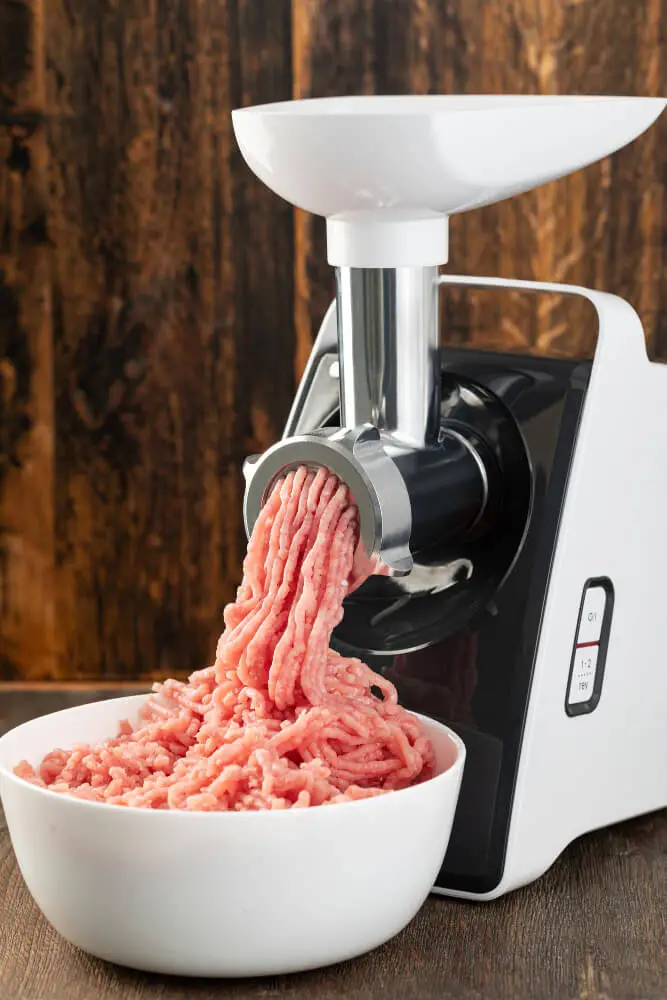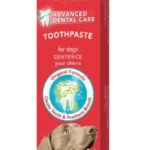Raw dog food, a biologically appropriate raw food (BARF) diet, has gained popularity among pet owners in recent years. These diets typically consist of raw meat, bones, fruits, vegetables, and supplements, mirroring the diet of dogs’ wild ancestors. Raw diets promote healthier coats, cleaner teeth, higher energy levels, and smaller stools. However, you might need a meat grinder for the bones and meat. What is the best meat grinder for raw dog food? Find our eight top picks below and why they are the best.
Benefits of Raw Dog Food
Raw dog food diets emphasize natural, unprocessed ingredients that are thought to offer a range of benefits. One of the most noticeable effects is a healthier and shinier coat, attributed to the fats and oils naturally present in raw meat. This diet can also contribute to cleaner teeth and fresher breath, as gnawing on raw bones acts as a natural toothbrush, reducing plaque and tartar buildup.
Furthermore, proponents of raw diets often report increased energy levels in their pets. The nutrient-dense food is more easily digestible, allowing dogs to better absorb and utilize the energy from their meals. Consequently, this can lead to a healthy weight, as dogs may feel fuller on less food than a traditional commercial diet.
Bowel health is another area where raw diets can potentially excel. These diets are high in protein and low in carbohydrates, so they produce smaller, less odorous stools. This is because the dog’s body utilizes more of the food, and less is being excreted as waste.
However, it’s critical to note that all dogs are different, and what works well for one may not be the best for another. As always, I recommend discussing a dog’s dietary needs and changes with a knowledgeable veterinarian. Your vet can provide guidance depending on your pet’s health status and dietary requirements.
Do All Dogs that Eat Raw Food Need a Grinder?
Yes, a grinder can be a beneficial tool for dogs on a raw food diet, especially for safety and digestive reasons. Raw bones, a staple of the raw food diet, can pose a choking hazard or cause damage to a dog’s mouth, throat, or intestines if not properly ground down.
Additionally, according to a study published in the Journal of Animal Physiology and Animal Nutrition, ground raw bones are more digestible for dogs than whole raw bones. Grinding the bones ensures that dogs can consume and digest necessary nutrients safely.
Similarly, grinding can help in making sure the dog absorbs the nutrients from vegetables, as dogs can struggle to break down plant cell walls. Therefore, a grinder can make a raw diet safer and more nutritionally beneficial for dogs.
Best Meat Grinder for Raw Dog Food
Are you looking for the best meat grinder for raw dog food? Here are some of the best grinders in the market.
STX Turboforce 3000 Series Electric Meat Grinder
The STX Turboforce 3000 Series stands out because of its durability and power. It features 3-speed settings, making it versatile for different grinding needs.
Features: A locked motor wattage of 3000 Watts, three speeds (High, Low, Reverse), and a Circuit Breaker for Safety. It includes three stainless blades, five grinding plates, a beaner plate, and three stuffing tubes.
Pros: High power, multiple speeds, and safety features make this grinder efficient and safe to use.
Cons: It’s a bit pricey and might be overly powerful for smaller dogs.
Sunmile SM-G31 Electric Meat Grinder
The Sunmile SM-G31 excels in its affordability and user-friendliness. It’s easy to clean, has solid motor power, and has a compact design.
Features: The grinder has a 350W motor, large capacity, three different stainless steel cutting plates, and one big sausage stuffing tube.
Pros: Large capacity and durable design.
Cons: It’s a bit expensive and not as powerful as some alternatives.
LEM Products Stainless Steel Big Bite Electric Meat Grinder
The LEM Big Bite Grinder offers an impressive grind speed and comes with a warranty. Its stainless steel body guarantees longevity.
Features: This grinder has a .75HP motor, stainless steel motor housing, metal gears, and a five-year factory warranty.
Pros: The machine is sturdy, durable, and has a generous warranty.
Cons: The cost is higher than many other grinders on the market.
Aobosi Electric Meat Grinder
The Aobosi Grinder shines with its multi-functionality and quiet operation. It features a reverse function for jammed meat.
Features: Comes with a powerful 800W motor, two durable stainless steel blades, and a reverse function.
Pros: Compact and efficient with a reverse function for safe use.
Cons: Small capacity might not be suitable for large breeds or multiple pet households.
Homeleader Meat Grinder
The Homeleader Grinder is popular its elegant design and easy assembly. It’s perfect for small to medium grinding tasks.
Features: Equipped with a powerful 800W motor and three different cutting plates.
Pros: Powerful and versatile with various cutting options.
Cons: Its design makes it difficult to clean.
ALTRA Stainless Steel Electric Meat Grinder
The ALTRA Grinder provides a strong motor and multiple accessories. It’s a good choice for grinding small bones.
Features: The machine has a powerful 2000W max power, three modes, three cutting plates, and one sausage tube.
Pros: Powerful and versatile, suitable for a variety of meat grinding.
Cons: It’s a bit larger and bulkier than some other models.
Happybuy Electric Meat Grinder
Happybuy’s Grinder offers high efficiency and is suitable for commercial use. Its large capacity is a plus, but it might be too large for home use.
Features: The grinder has a 1.5HP motor, adjustable speeds, and multiple accessories.
Pros: Powerful and versatile, with adjustable speeds for different grinding needs.
Cons: The higher price tag might not fit into everyone’s budget.
Gourmia GMG525 Electric Meat Grinder
The Gourmia GMG525 is lauded for its compactness and affordability. It’s easy to use and clean, but the motor might not hold up against heavy-duty grinding.
Features: Features include a powerful 500W motor, three stainless steel blades, a food pusher, and a kibbeh attachment.
Pros: Compact and affordable with a variety of blade options.
Cons: Not as powerful or durable as some other options.
Tips for Shopping for a Meat Grinder
When shopping for a meat grinder, pay attention to the power of its motor. A high-wattage device can easily handle larger bones and grinding tasks. Check the grinder’s size and weight. Compact, lightweight models are easier to store and maneuver.
Consider the grinder’s durability. Stainless steel models typically last longer and resist wear and tear. Look at the grinder’s speed settings. Multiple options allow for better control and versatility. Don’t forget about the noise level, as quieter models can be more comfortable to use at home. Lastly, consider price and warranty. A grinder that fits your budget and has a good warranty offers better peace of mind.
Step-by-Step Process on How to Grind Raw Dog Food Bones
To grind raw dog food bones using a meat grinder, follow the steps below:
- Preparation: First, ensure you have a clean and sanitary surface for preparing the bones. Cleanliness is crucial to prevent any potential bacterial contamination. Ensure your grinder is clean, assembled correctly, and ready for use.
- Selection of Bones: Choose the right bones for your pet. Chicken and turkey bones are a good choice for small and medium dogs. You can opt for bigger bones, such as beef or lamb, for larger dogs. Avoid using bones that can splinter, like cooked or small bird bones.
- Freezing the Bones: To make the grinding process easier, freeze the bones for about 15 minutes before grinding. This step will help to harden the bones, making it easier for the grinder to process them.
- Grinding: Place the bone into the feeding bar of the grinder and use the pusher to push it down towards the blade. Make sure to do this slowly to avoid damaging the grinder. Always keep your fingers away from the feeding bar to prevent injury.
- Checking the Grind: After grinding, ensure the bone has been ground to the right consistency. There should not be any large, sharp fragments that could harm your dog.
- Clean Up: Once you’ve finished grinding, immediately clean your grinder to prevent bacteria buildup. Take apart the grinder and wash all the components thoroughly. Make sure to dry everything entirely before reassembling to prevent rust.
- Storage: Store the ground bone in airtight containers and keep it in the refrigerator if you plan to use it within a few days. For more extended storage, freeze the ground bone to preserve its freshness.
Always supervise your dog when feeding them ground bones to ensure they don’t choke or ingest too much at once.
Should I Use A Meat Grinder As A Food Mill?
While meat grinders and food mills perform somewhat similar tasks, they are not exactly interchangeable. A meat grinder is designed specifically for grinding meat and occasionally bones. Food mills, on the other hand, are more versatile. They can puree or mash a variety of foods, including fruits, vegetables, and legumes.
However, if you are without a food mill and need to process soft foods such as cooked fruits or vegetables, a meat grinder could be used as a makeshift food mill. Nevertheless, it’s essential to keep in mind that the results may not be as smooth as those achieved with a traditional food mill, and hard items like raw vegetables or whole spices may damage the grinder. Hence, while a meat grinder can perform a similar function in some scenarios, it should not be considered a direct replacement for a food mill.
Is A Meat Grinder A Food Processor?
A meat grinder is not a food processor, although they both have their place in a well-equipped kitchen. A meat grinder is a unitasker explicitly designed for grinding meat and sometimes bones, while a food processor is a multitasker.
Food processors can chop, slice, shred, blend, and puree a wide variety of foods. So, although there is some overlap in their functionalities, each tool is best for particular tasks. Therefore, each produces different results. For example, a food processor might handle raw meat to make items like minced meat or burger patties, but it doesn’t do so as efficiently as a meat grinder.
Similarly, a meat grinder would struggle with jobs like chopping vegetables or making emulsions, which a food processor handles easily. Thus, they are not interchangeable; each tool brings unique capacities to a kitchen setup.
Benefits of Grinding Your Dogs Raw Food
Yes, there are several benefits to grinding your dog’s raw food. Firstly, grinding raw food can make it easier for dogs to chew, especially if they are young, elderly, or have dental issues.
Secondly, it can aid digestion, as smaller pieces are generally easier for dogs to process. Grinding also allows for a more homogenous mixing of different ingredients, ensuring a balanced intake of nutrients in every bite.
Finally, it can simplify portion control, as ground food can be easily measured and portioned out. However, it is essential to remember that bones should never be ground too finely, as some bone fragments benefit dental health. Always consult a veterinarian or canine nutrition expert before transitioning your dog to a raw diet.
Can I Make a Homemade Meat Grinder for Raw Dog Food
Yes, you can. However, creating a homemade meat grinder for raw dog food comes with numerous challenges and is not the best option. It would require an understanding of mechanics and access to suitable materials, such as stainless steel, to ensure food safety.
The grinder must be carefully designed and constructed to avoid any risk of contamination or harm to the user. Furthermore, even if a homemade grinder were successfully built, it would likely be less efficient and durable than a commercial model. On the other hand, there are alternatives to buying a new commercial grinder. For instance, you could consider renting a grinder or purchasing a second-hand model.
Alternatively, some butchers or pet stores may offer grinding services, where you can have your dog’s raw food ground for a small fee. Cleanness is paramount when handling raw food to prevent bacterial contamination.
Advantages Of Using An Electric Meat Grinder For Raw Dog Food
Utilizing an electric meat grinder for raw dog food has numerous merits. First and foremost, it is a time saver. The powerful motor can grind through large amounts of meat and bone quickly and effortlessly, reducing preparation time significantly.
Furthermore, the electric grinder gives you control over the grind’s coarseness, allowing you to tailor the consistency to your pet’s preferences and dietary needs. This is especially advantageous for pets with specific dietary restrictions or dental issues. Also, the uniformity of the grind facilitates an even distribution of nutrients, ensuring that each meal is nutritionally balanced.
Lastly, electric grinders are often equipped with safety features, such as emergency stop buttons and overload protection, offering an added layer of safety. However, keep in mind that they require regular cleaning and maintenance to keep them running efficiently and to prevent bacteria buildup.
What Are The Best Heavy-Duty Meat Grinder For Bones
In the market for meat grinders, a few stand out as particularly well-suited for grinding bones due to their heavy-duty build. The STX Turboforce Classic 3000 Series is one such model, praised for its powerful motor and high durability.
Another reliable choice is The Weston (10-3201-W) Pro Series, renowned for its robust construction and high-capacity grinding. The LEM Products Stainless Steel Big Bite Electric Meat Grinder is highly recommended, particularly for its fast yet precise grinding capability.
However, a heavy-duty meat grinder becomes necessary only under specific circumstances. If you regularly prepare raw meals for a large breed dog or have multiple pets, a heavy-duty grinder can significantly simplify the process and save time.
It’s also helpful if you’re grinding larger, denser bones, such as those from beef or pork, as standard grinders can’t handle these. Remember, only invest in a heavy-duty grinder if it aligns with your pet’s dietary needs and your meal preparation habits. Always consult a veterinary nutrition expert to ensure that ground bones suit your pet’s diet.
Is A Dry Dog Food Grinder Necessary?
Whether a dry dog food grinder is necessary depends on your pet’s needs and feeding practices. Some dogs with dental issues or elderly dogs may struggle with dry kibble and could benefit from the food being ground into a more manageable consistency.
Similarly, if you’re looking to transition a cat from wet food to dry, grinding the dry food and mixing it with the wet can help ease the transition. Nevertheless, for most healthy dogs, grinding is unnecessary, and chewing on kibble can even help improve dental health by reducing plaque buildup. Therefore, while a dry dog food grinder can be useful in certain situations, it is not necessary for all pet owners. Always ensure that any changes to your pet’s diet are done under the guidance of a veterinary professional.
NB Be Cautious About Raw Chicken: A 2019 study published in Vet Record found that raw chicken was linked to a heightened risk of a paralyzing condition called acute polyradiculoneuritis (APN). Therefore, you need to consult your vet for better guidelines on feeding your dog raw chicken. Alternatively, you can feed it rotisserie chicken.
Found the best grinder for raw dog food? As always, it is important to consult with a veterinarian before making major changes to your pet’s diet, like feeding it raw food.





